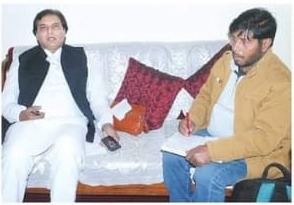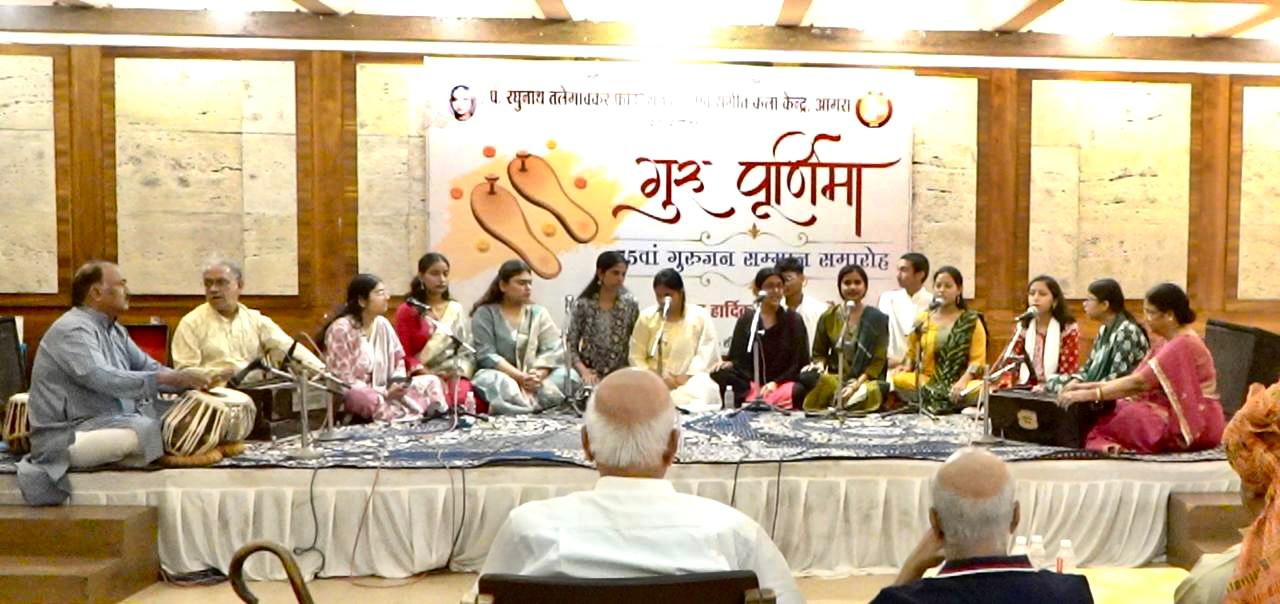Conversation with true funkaari maestro Akram Khan tells about Riyaz and preparation
Anand Agnihotri in conversation with Ustad Akram Khan
Talent can never be hidden. What can I say if it is a family talent? In the world of Indian classical music, the dynasties which started singing, playing and dancing in a specific style were called gharanas. The way mixed styles of singing, playing and dancing were seen and heard, the question began to be raised whether the gharanas would survive or not? The good thing is that the musicians are honest about their music.
If they present something from another gharana, they tell which gharana it belongs to. Tabla playing is such a genre of music which can be considered as salt in pulses. Be it singing, playing or dancing, it cannot take any form without Avandha Vaad. Just as pulses become distasteful if there is no or too much salt in it, the tabla has the same place in music. Be it solo or accompaniment, if the percussionist does not play as per the program then it is considered unsuccessful.
While in solo recital the tabla player is free to show his preparation, in sangat he has to accompany the singer, instrumentalist or dancer accordingly. Actually, Ustad Sidhar Khan started tabla playing from Delhi and established Delhi Gharana. After this, the artists of this gharana scattered across the country and also formed their own gharanas according to specific styles. Ajrada Gharana is one of them. This style of tabla playing was born by two brothers, Ustad Kallu Khan and Ustad Meeru Khan, in Ajrada village of Meerut district.
Although both of them were disciples of Ustad Sitab Khan of Delhi Gharana, but they gave birth to Ajrada Gharana through their own restrictions. Now Ustad Akram Khan is holding the reins of this gharana. He took training in tabla playing from his grandfather Ustad Mohammad Shafi Khan, Niazu Khan and Walid Ustad Hashmat Ali Khan. He has earned a lot of name not only in the country but also abroad. He is running his own academy in Delhi. He has also been a visiting professor at the University of Washington. He has participated in almost all the music festivals of the country.
Apart from playing solo, he has also shown his talent in accompaniment with all the senior musicians. He had come to Meerut to accompany the sitar playing of Ustad Shahid Parvez Khan. On this occasion, we talked to the news editor of Dainik Janvani, Meerut about tabla playing and Ajrada Gharana. Here are the main excerpts from the conversation.
Anand Agnihotri
Your family is Ajrada but it has flourished in Delhi and other places. He answers the question very seriously as to why this is happening, that most of the musical gharanas are from Uttar Pradesh, but unfortunately, today there are no prominent artists of that gharanas from where these gharanas originated. Banaras is an exception to this. Most of the artists are out. Ajrada Gharana is not an exception to this. This is not without reason.
When there used to be kings, princely states and landlords, we used to get shelter from them. Our art flourished under his patronage. Now the kings and emperors are no more, Ajrada is a small village. Even our daily financial needs could not be met by staying here, so we had to come to Delhi. But the smell of Ajrada soil is present in every fiber of our being. A similar situation happened with other families also.
When asked which gharana’s tabla playing he considers better, the maestro says with a smile that one cannot be compared with the other. There are many gharanas in Uttar Pradesh like Banaras, East, Farrukhabad, Hapur, Sahaswan Ajrada. The masters and artists of all the gharanas are talented. Present solo and accompaniment programs as per their own. As far as skill is concerned, if you have cleanliness, preparation and understanding then you can create color on any stage, irrespective of the family you belong to. But half-baked preparations don’t help. Ajrada Gharana also has its own characteristics. One of them is its horizontal shape, that is, because of its horizontal restrictions, it has been named Ajrada. Ajrada Gharana does not sit weak in comparison to any other Gharana. Our playing style is appreciated all over the country and abroad.
On the question of continued existence of gharanas, the maestro says that gharanas can never disappear. It is a different matter that the artists of the gharanas are not at their original place. But those who have gone to other places are expanding the art of their Gharana as per their capacity. The new generation that is taking lessons from the masters will keep the teachings of these gharanas alive. As long as people keep taking gharanadar education, gharana will continue.
When asked about the newcomers, a slight bitterness appears on the maestro’s face. Ustad Akram Khan says that new children are coming forward with full dedication to take training in music but the attitude of the government cannot be considered right. Practical used to be mandatory in high school and intermediate but the government abolished this requirement. However, the government is now correcting its mistake. Music is again being given a place in the curriculum. Anyway, music is a subject of performance, theory is for knowledge.
The demonstration itself shows how seriously you have taken the theory. It would have been better if the government had made arrangements for scholarships etc. for the promising ones so that the children could move forward without any financial problems and could do new research. When children come out of music training, the biggest question they face is what to do next. Not only are there not so many posts for music teachers, music festivals are also being organized less now than before. Organizers also face financial problems and become helpless. The government should help in organizing such events so that the celebrations continue smoothly and the musicians are also sustained.
When asked about Mujra culture, Ustad says that people have a big misconception about women dancing and singing in Mujra. At that time brothel did not mean prostitution. True training in music was given there. The dancers used to give respect to the singers. Everyone respected each other. Thumri, Chaiti, Dadra, all these are the contribution of Mujra culture. Mujras were also held in Meerut. It would not be unfair to say that Meerut was a major stronghold of women performing Mujra. As far as I remember, there was a period of Mujras in Meerut from 1930 to 1980.
During this period, there were many women who earned fame by singing at big places. It would not be good to take anyone’s name in this because the new generation interprets Mujra as something else. Now when there are no people left to go to Mujra, it was inevitable that they would end. However, singing like Thumri, Chaiti and Dadra, coming out of the brothel, is proving to be very meaningful and today it is sung with pride on big stages.
On how difficult tabla playing is in Mujra, the maestro says that there is nothing difficult. Constant practice is needed. In that period, there was a special category of percussionists who were experts in playing the mujra. But now when there are no Mujras left, this style of playing is also becoming extinct. Even now in Bollywood, one can hear such tabla playing in films where Mujra is performed. In such a situation, it cannot be assumed that the style of Mujra playing has completely disappeared. However, had my father Ustad Hashmat Ali Khan been there, he could have given more information about this. This is all the information I have.
The new generation is becoming more inclined towards playing tabla in music, on this the maestro says that yes, the number of tabla players has increased here in the last few years.Nowadays, more parents bring their children and ask them to teach them tabla. I ask why only Tabla, the answer I get is that the child is more interested in playing Tabla. Well, it is a good thing that the inclination of children towards playing Tabla is increasing. There is a need for skilled tabla players in every music festival. If competition increases in any art then the form of that art becomes more visible.
Tell me any memory of your life where you enjoyed playing the tabla the most. The maestro gets lost for a few minutes and then says that I enjoy playing the tabla in every concert. Be it solo playing or accompanying any artiste. In my life, I have studied under Ustad Vilayat Khan, Pt. Ravi Shankar, Pt. Rajan-Sajan Mishra, Pt. Jasraj, Ustad Amjad Ali Khan, Dr. L. Subramaniam, Ustad Sultan Khan, Pt. Debu Chaudhary, Pt. Shivkumar Sharma, Pt. Hari Prasad Chaurasia, Pt. Birju Maharaj, Pt. Bhajan Sapori, Pt. I have had the opportunity to associate with great people like Tejindra Majumdar, Pt. Subhendra Rao, Dr. MS Gopalakrishnan, Pt. Rajendra Gangani and Deepak Maharaj. Everyone has appreciated and blessed me. There is a reason for this also. When I associate with someone, I get lost with the artist. This engrossment is what makes my company beautiful.
When asked to what extent Kathak and Tabla can be promoted because of Bollywood, he says that Kathak and Tabla are being practiced in the country even before the birth of Bollywood. Yes, it is true that through films, some interest has been aroused among the common people towards it. But both these genres are not dependent on the shoulders of Bollywood. On the contrary, our classical artists have made Bollywood shine with their skills.
Share this content:










Post Comment